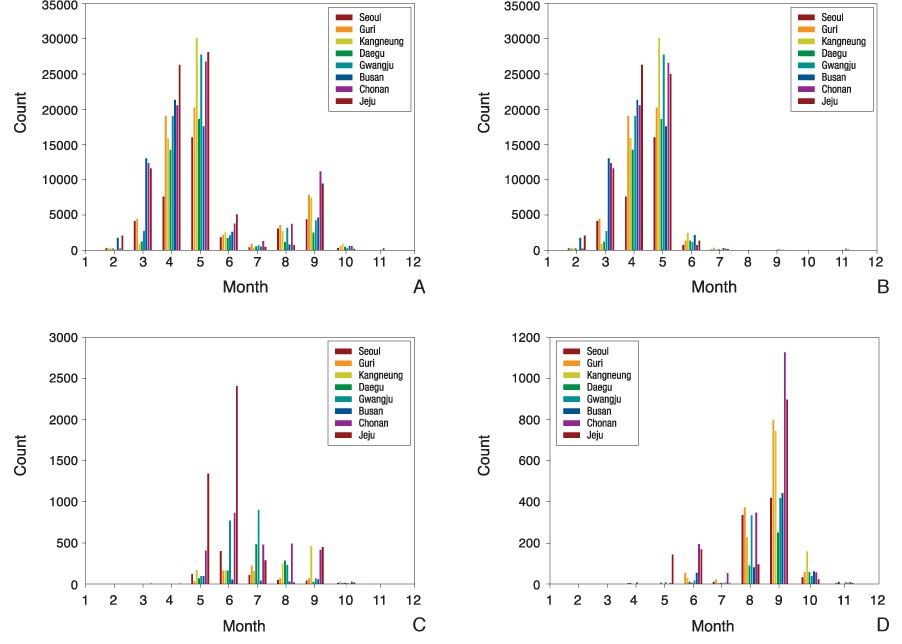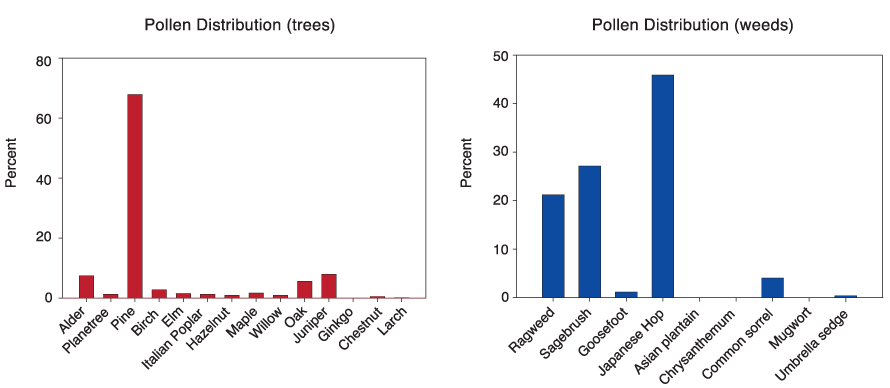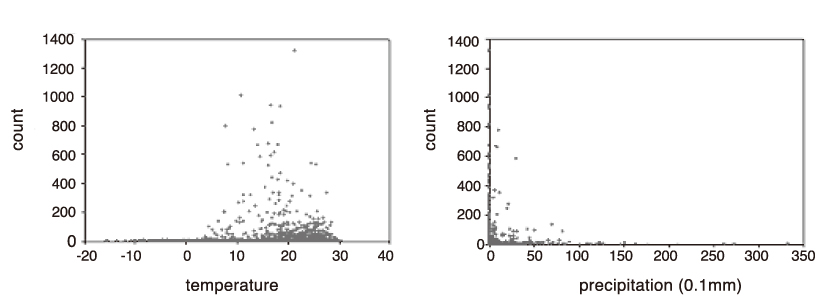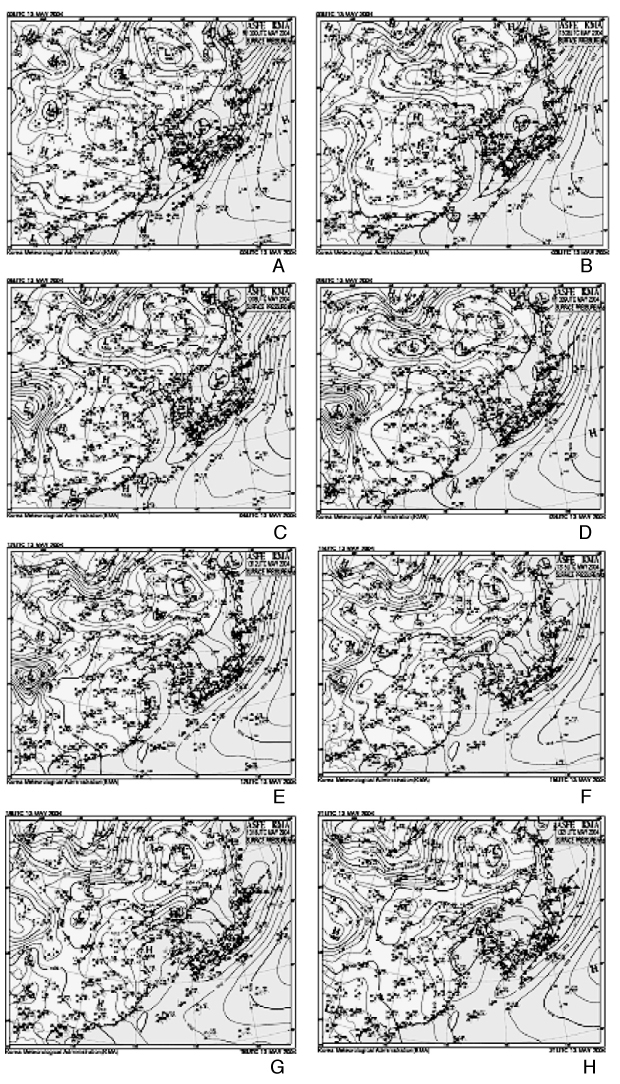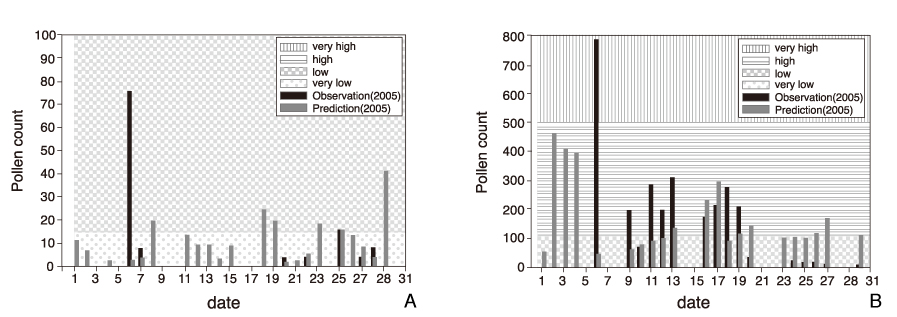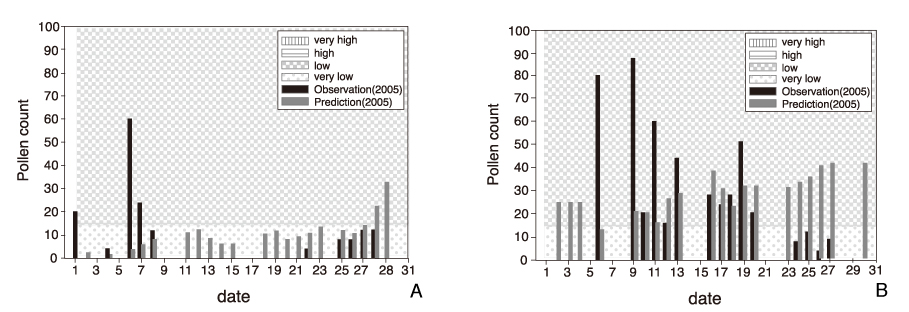Development of Pollen Concentration Prediction Models
- Affiliations
-
- 1Department of Pediatrics, Hanyang University College of Medicine, Korea.
- 2Korean Academy of Pediatric Allergy and Respiratory Diseases, Committee of Pollen Study, Korea. jaewonoh@hanyang.ac.kr
- KMID: 2065053
- DOI: http://doi.org/10.5124/jkma.2009.52.6.579
Abstract
- Air-borne pollen is known as one of the major causal agents to respiratory allergic reactions. The daily number of pollen grains was monitored using Burkard volumetric spore traps at eight locations including Seoul and Jeju during 1997-2005. Pollen grains were observed throughout the year especially from February to November. They showed similar distribution patterns of species among locations except Jeju, where Japanese cedar vegetation is uniquely found. The peak seasons for pollen grains from trees, grasses, and weeds were from March to May, May to September, and August to October. Tree pollens were mainly composed of pine, oak, alder, and birch. Weed pollens were mainly from Japanese hop, sagebrush, and ragweed. The diameter of pollen grains, which has a typical range of 20~60 micrometer, has close relationship with allergenicity. The allergenicity of trees and weed pollens is higher than that of grass pollens in general. Daily fluctuations in the amount of pollens have to do with a variety of meteorological factors such as temperature, rainfall, and the duration of sunshine. Temperature and rainfall are especially decisive in determining pollen concentrations. Ten weather elements that are thought to affect the concentration of pollens are used to develop equations for the pollen forecasts. Predictive equations for each pollen species and month are developed based on statistical analyses using observed data during the last 5 years in Seoul through a co-work with the Committee of Pollen Study in Korean Academy of Pediatric Allergy and Respiratory Diseases and National Institute of Meteorological Research.
Keyword
MeSH Terms
Figure
Cited by 10 articles
-
A Six-Year Study on the Changes in Airborne Pollen Counts and Skin Positivity Rates in Korea: 2008–2013
Hye Jung Park, Jae-Hyun Lee, Kyung Hee Park, Kyu Rang Kim, Mae Ja Han, Hosoeng Choe, Jae-Won Oh, Chein-Soo Hong
Yonsei Med J. 2016;57(3):714-720. doi: 10.3349/ymj.2016.57.3.714.Impacts of climate change on aeroallergens
Hyun Jung Jin, Jeong-Eun Kim, Joo-Hee Kim, Hae-Sim Park
J Korean Med Assoc. 2011;54(2):156-160. doi: 10.5124/jkma.2011.54.2.156.The impact of climate change on aeroalleregen and pediatric allergic diseases
Hyeon Jong Yang, You Hoon Jeon, Taek Ki Min, Bu Soon Son, Kwan Jun Park, Jong Youn Moon, Bok Yang Pyun
J Korean Med Assoc. 2011;54(9):971-978. doi: 10.5124/jkma.2011.54.9.971.Identification of immunoglobulin E binding components of two major tree pollens, birch and alder
Moon-Gyung Yoon, Mi-Ae Kim, Hyun-Jung Jin, Yoo-Seob Shin, Hae-Sim Park
Allergy Asthma Respir Dis. 2013;1(3):216-220. doi: 10.4168/aard.2013.1.3.216.Identification of IgE binding components of two major weed pollens, ragweed and mugwort
Moon-Gyung Yoon, Mi-Ae Kim, Hyun-Jung Jin, Yoo-Seob Shin, Hae-Sim Park
Allergy Asthma Respir Dis. 2014;2(5):337-343. doi: 10.4168/aard.2014.2.5.337.Evaluation of the association of vegetation of allergenic plants and pollinosis with meteorological changes
Joo-Hwa Kim, Jae-Won Oh, Ha-Baik Lee, Seong-Won Kim, Hai-Lee Chung, Myung-Hee Kook, Kang-Seo Park, Bong-Seong Kim, Ja-Kyung Kim, Dong-Jin Lee, Won-Ki Paik, Kyu-Rang Kim, Hey-Lim Lee, Young-Jin Choi, Seung-Do Yu, Jeong-Hwa Kim, Yong-Seong Cho
Allergy Asthma Respir Dis. 2014;2(1):48-58. doi: 10.4168/aard.2014.2.1.48.The impact of climate change on pollen allergy in Korea
Jae-Won Oh
Allergy Asthma Respir Dis. 2018;6(Suppl 1):S31-S39. doi: 10.4168/aard.2018.6.S1.S31.Characteristics of airborne pollen in Incheon and Seoul (2015–2016)
Hye Ju So, Soon Jeong Moon, Seon Yeong Hwang, Jeong Hee Kim, Hae Ji Jang, Jung Heum Jo, Tae Jung Sung, Dae Hyun Lim
Asia Pac Allergy. 2017;7(3):138-147. doi: 10.5415/apallergy.2017.7.3.138.Cross-allergenicity between dandelion and major weed pollens
Ji Hye Kim, Moon-Kyung Yoon, Mi-Ae Kim, Yoo-Seob Shin, Young Min Ye, Hae-Sim Park
Allergy Asthma Respir Dis. 2015;3(5):358-364. doi: 10.4168/aard.2015.3.5.358.Analysis of regional prevalence of allergic diseases in Korean school children
Yeonhee Lee, Jaehee Choi, Mi-Ran Park, Jihyun Kim, Woo Kyung Kim, Yong Mean Park, So-Yeon Lee, Man Young Han, Yoomi Chae, Myung-Il Ham, Kee-Jae Lee, Ho-Jang Kwon, Kangmo Ahn
Allergy Asthma Respir Dis. 2015;3(1):62-69. doi: 10.4168/aard.2015.3.1.62.
Reference
-
1. Lewis WH, Vinay P, Zenger VE. Airborne and allergenic pollen of North America. 1983. Baltimore & London: The Johns Hopkins University Press.2. Esch RE, Bush RK. Adkinson NF, Yunginger JW, Busse WW, Bochner BS, Holgate ST, Simons FER, editors. Aerobiology of outdoor allergens. Middleton's allergy princiles and practice. 2003. 6th ed. St. Louis: Mosby;529–555.
Article3. Taylor G, Walker J, Backley CH. 1820-1900: A detailed description of the astonishing achievement of Backley in describing the causes of hay fever. Clin Allergy. 1973. 3:103–108.4. Lewis W, Imber W. Allergy epidemiology in the St. Louis, Missouri Area II, grasses. Ann Allergy. 1975. 35:42–50.5. Anderson JH. Allergenic airborne pollen and spores in Anchorage, Alaska. Ann Allerg. 1985. 54:390–399.6. Potter PC, Cadman A. Pollen allergy in South Africa. Clin Exp Allergy. 1996. 26:1347–1354.
Article7. Esch RE, Bush RK. Adkinson NF, Yunginger JW, Busse WW, Bochner BS, Holgate ST, Simons FER, editors. Aerobiology of outdoor allergens. Middleton's allergy princiles and practice. 2003. 6th ed. St. Louis: Mosby;529–555.
Article8. Solomon WR, Weber RW, Dolen WK. Bierman CW, Pearlman DS, Shapiro GG, Busse WW, editors. Common allergenic pollen and fungi. Allergy, asthma and immunology from infancy to adulthood. 1996. 3rd ed. Philadelphia: WB Saunders;93–114.9. Oh JW. Characteristics and distribution of airborne pollen and mold. J Pediatr Allergy Respir Dis. 1998. 8:1–15.10. Oh JW, Lee HL, Kim JS, Lee KI, Kang IJ, Kim SW, Lee HB. Aerobiological study of pollen and mold in the 10 states of Korea. Pediatr Allergy Respir Dis (Korea). 2000. 10:22–33.11. Oh JW, Pyun BY, Choung JT, Ahn KM, Kim CH, Song SW, Son JA, Lee SY, Lee SI. Epidemiological change of atopic dermatitis and food allergy in school-aged children in Korea between 1995 and 2000. J Korean Med Sci. 2004. 19:716–723.
Article12. Vázquez LM, Galán C, Domínguez-Vilches E. Influence of meteorological parameters on olea pollen concentrations in Cordoba (South-Western Spain). Int J Biometeorol. 2003. 48:83–90.13. Emberlin J, Savage M, Jones S. Annual variations in grass pollen seasons in London 1961-1990: trends and forecast models. Clinic Exp Allergy. 1993. 23:911–918.
Article14. Frenguelli G, Bricchi E. The use of phenoclimatic model for forecasting the pollination of some arboreal taxa,. Aero-biologia. 1998. 14:39–44.
Article15. Galán C, Cari-anos P, García-Mozo H, Alcázar P, Domínguez-Vilches E. A model for forecasting Olea europaea L. airborne pollen in the South-West Andalucia, Spain. Int J Biometeorol. 2001. 45:59–63.
Article16. Garchia-Mozo H, Galán C, Gomez-Casero MT, Domínguez-Vilches E. A comparative study of different temperature accumulation methods for predicting the start of the Quercus pollen season in Córdoba (South West Spain). Grana. 2000. 39:194–199.
Article17. Smith M, Emberlin J. A 30-day-ahead forecast model for grass pollen in north London, United Kingdom. Int J Biometeorol. 2006. 50:233–242.
Article18. Beggs PJ. Impacts of climate change on aeroallergens: past and future. Clin Exp Allergy. 2004. 34:1507–1513.
Article19. Ziska LH, Gebhard DE, Frenz DA, Faulkner S, Singer BD, Straka JG. Cities as harbingers of climate change: common ragweed, urbanization, and public health. J Allergy Clin Immunol. 2003. 111:290–295.
Article20. Wayne P, Foster S, Conolly J, Bazzaz , Epstein P. Production of allergenic pollen by ragweed (Ambrosia artemisiifolia L.) is increased in CO2-enriched atmospheres. Ann Allergy Asthma Immunol. 2002. 88:279–282.
Article
- Full Text Links
- Actions
-
Cited
- CITED
-
- Close
- Share
- Similar articles
-
- Deep Neural Network-Based Concentration Model for Oak Pollen Allergy Warning in South Korea
- The impact of climate change on pollen allergy in Korea
- Revision of threshold levels for evoking pollinosis to oak, pine, Japanese hop, and ragweed in the metropolitan area Seoul, Korea
- Characteristics of airborne pollen in Incheon and Seoul (2015–2016)
- Evaluation of the association between pollen count and the outbreak of allergic disease

